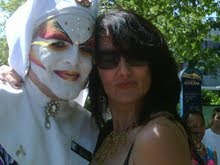Thriving 'Diva' reflects the growth of the lesbian scene
Jane Czyzselska tells Rachel Shields that her magazine is also attracting straight women
Coming of age is traditionally a difficult time but for Diva, Europe's only mainstream lesbian magazine, its 16th birthday next month couldn't come at a more secure period in its history. The magazine's trajectory has mirrored the growth of Britain's lesbian scene. In 1994 it was sold bimonthly in independent bookshops; now every four weeks a new issue hits the shelves at newsagents and supermarkets.
Life for gay women has changed radically since the magazine's launch. Political shifts have included the repeal of Section 28, which banned the promotion of homosexuality, and the introduction of civil partnerships. Cultural shifts have seen lesbianism become much more widely accepted, changes the magazine has echoed.
"The tone is much lighter than it was five years ago," says editor Jane Czyzselska, 41. "Enormous things have happened in that time in terms of lesbian visibility. We launched in a very different cultural climate."
While the magazine has undergone significant changes since the former London Paper columnist took the helm in 2004 – more fashion coverage and a revamped layout – coverage of serious issues led to Czyzselska being nominated for gay rights group Stonewall's Journalist of the Year award in 2009. "Diva is political with a small 'p'," she says. "We'll be carrying interviews with all the leaders in the run-up to the election. We also do quite a lot of stuff about human rights in other countries, and what that means for lesbians here."
Diva was founded in 1994 by the Millivres Prowler Group, which also pub- lishes Gay Times and AXM Digital. Britain's 1.8 million lesbian and bisexual women are picking from a field of one when they buy Diva, which may have helped the magazine maintain its 55,000 circulation during the downturn. "We are stable on sales and on advertising income. Growth has happened exponentially," says Czyzselska. "Because there is no competition, we are aiming at every lesbian – and you can't meet the needs of every lesbian all of the time," she says. Diva is bought by those in their mid-teens to their 60s, with the average reader being 33. "We try to reflect issues which our readers feel affect their lives."
These range from topics such as mental health, drug abuse and eating disorders, to lighter features on sex, relationships and fashion. "I wrote an article which was quite personal about eating disorders, and a lot of people wrote back saying 'I thought I was the only one'. If we help people feel less isolated, then that makes me happy," says Czyzselska.
That wasn't the first time she has opened up about her private life in print. She wrote a column in the London Paper in which she recounted her lively love life. "It is great that a mainstream publication can carry a column about lesbian relationship issues. For so long the lesbian world has been shrouded in mystery. To get an insight into a person's life was interesting for non-lesbian readers. I would have straight men and women writing to me saying they liked it, that it was nice to see another expression of female sexuality."
Czyzselska's tenure at the London Paper abruptly ended in 2008 when she was replaced by another columnist. "They wanted someone younger," she says breezily. "It felt like it was a natural end. Writing endlessly about one's personal life can be quite trying on one's partners."
When she took over at Diva she was keen to dispel the myth that all lesbians favour a uniform of Doc Martens, cropped hair and sleeveless tops, and set about expanding the magazine's fashion pages. Diva has since bagged lucrative advertising from such high-end labels as Yves Saint Laurent.
"The way that we dress is important, and there are as many different styles of lesbian dress as there are youth styles. Some are into DayGlo clothes, others have a more beatnik style and some are into full-on glamour. Super-trendy Dalston kids are the ones wearing the Doc Martens now," says Czyzselska, herself dressed stylishly in black.
The magazine hasn't escaped the cult of celebrity, gradually trading in the lesser-known lesbian film directors and artists for a range of glamorous celebrities, some of them straight. Penelope Cruz, Beth Ditto, Anna Friel and Megan Fox have all appeared under the Diva masthead. "At first, we didn't have straight celebrities on the cover. Friel was the exception; she'd done the lesbian kiss in Brookside. Now we have people who play lesbians or who are bisexual."
But while most readers are lesbian or bisexual, Czyzselska believes the magazine has something to offer women of any orientation.
"A lot of straight women I know read it and like it, because it shows different ways of being a woman. It reflects a more diverse range of females than most magazines."
http://www.independent.co.uk/news/media/press/thriving-diva-reflects-the-growth-of-the-lesbian-scene-1891479.html
http://www.independent.co.uk/news/media/press/thriving-diva-reflects-the-growth-of-the-lesbian-scene-1891479.html





No comments:
Post a Comment